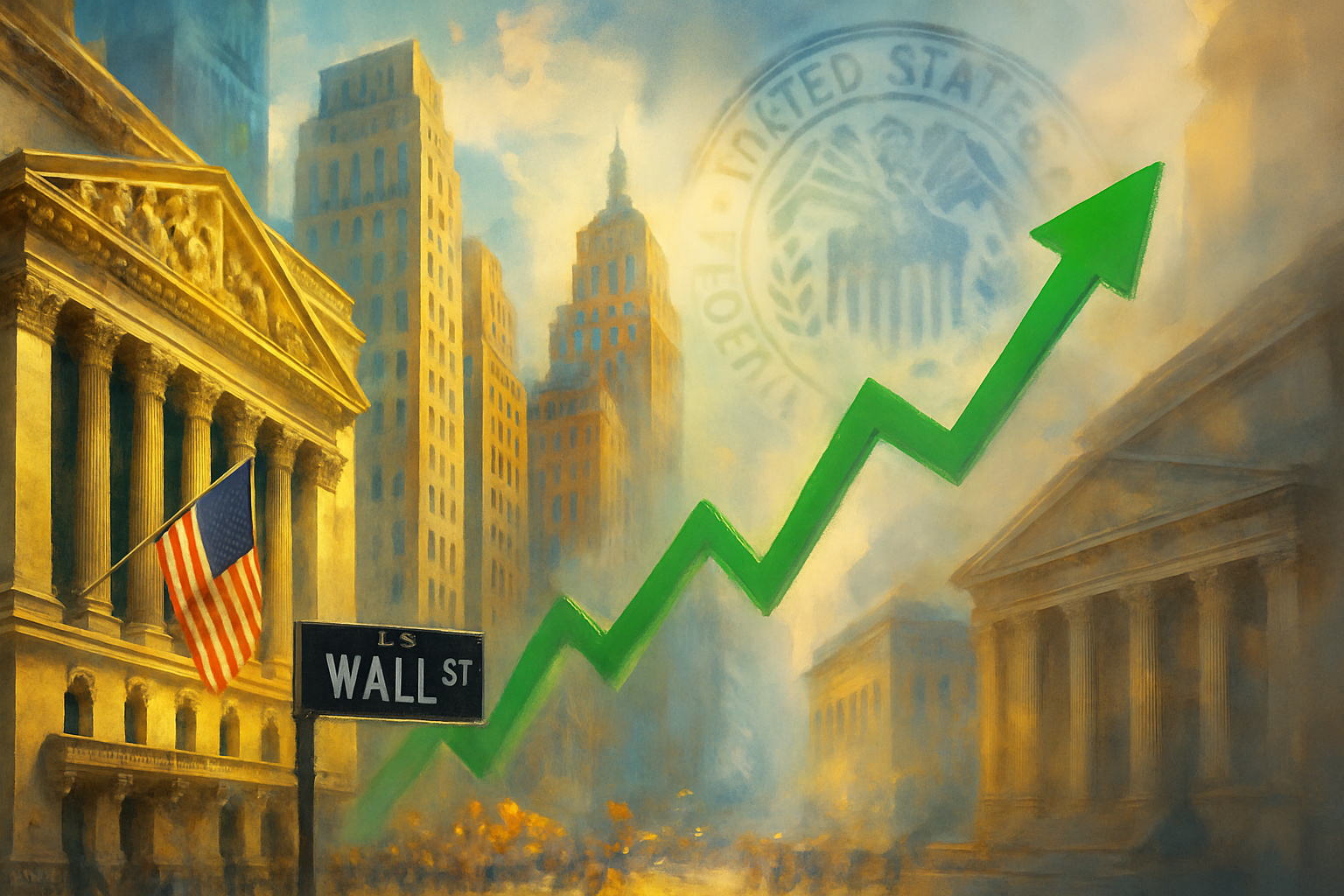
Wall Street is currently experiencing a fervent wave of optimism, dubbed 'Fed Cut Fever,' as hopes for aggressive Federal Reserve interest rate cuts dominate market sentiment. This bullish outlook has propelled major U.S. stock indices to fresh record highs, even as the nation grapples with an ongoing government shutdown and a challenging environment of economic data uncertainty. Investors are betting heavily on a more accommodative Fed, anticipating that cheaper money will fuel growth and sustain the market's upward trajectory, despite mixed economic signals and a looming data vacuum.
The prevailing sentiment on October 3, 2025, is overwhelmingly bullish, largely driven by the expectation of imminent Federal Reserve rate cuts. Following a 25-basis-point (bp) rate cut in September 2025—the first in several months—which brought the federal funds rate to a range of 4.00% to 4.25%, market participants are now pricing in further aggressive easing. The CME FedWatch Tool indicates a staggering 98% probability of another 25-basis-point cut at the upcoming October 29, 2025 FOMC meeting, with an 87% chance for a subsequent 25-basis-point reduction in December. This forward-looking optimism has seen the S&P 500 (NYSE: SPY) and Nasdaq 100 (NASDAQ: QQQ) hit fresh record highs, signaling a pronounced "risk-on" shift in investment strategies.
Detailed Coverage: Navigating Uncertainty Towards Easier Money
The "Fed Cut Fever" is not merely speculative; it is rooted in recent economic developments and the Federal Reserve's evolving stance. The September 2025 rate cut was largely interpreted as a "risk management cut" by Chair Jerome Powell, aimed at preemptively addressing a softening labor market and preventing an economic downturn, even as inflation remains above the Fed's 2% target. This pivot marks a philosophical shift towards a more agile and flexible monetary policy, moving away from rigid, forecast-dependent frameworks.
A key catalyst for the intensified "Fed Cut Fever" was a surprisingly disappointing September private-sector jobs report, which indicated a decline of 32,000 jobs against an expected gain. This data point reinforced investor belief in a deteriorating U.S. labor market, strengthening the argument for more aggressive rate cuts to avert further economic weakness. Consequently, Treasury yields have declined, and the U.S. dollar has weakened to its lowest levels year-to-date, making dollar-denominated assets less appealing and potentially boosting international investments.
However, this bullish market momentum is unfolding against a backdrop of significant uncertainty. The U.S. government officially shut down on October 1, 2025, halting the operations of numerous federal agencies responsible for collecting and disseminating vital economic statistics. This "data blackout" has indefinitely postponed crucial reports like the September Employment Situation Report, the Consumer Price Index (CPI), and third-quarter GDP figures. This leaves the Federal Reserve effectively "flying blind," complicating its data-dependent approach to monetary policy. While some analysts suggest this uncertainty could make the Fed hesitant, others argue it might push the central bank to cut rates preemptively to prevent undetected economic deterioration, drawing parallels to past crises. Political pressure from figures like President Trump and Federal Reserve Governor Stephen Miran, advocating for substantial rate cuts, further complicates the Fed's decision-making process, highlighting potential internal debates within the central bank.
Companies and Sectors: Winners and Losers in an Easing Cycle
The anticipated shift to a lower interest rate environment will inevitably create a divergence in performance across various sectors and public companies.
Potential Winners:
- Growth Stocks (Technology, Small-Caps): Companies with high growth potential, particularly in technology (e.g., NVIDIA (NASDAQ: NVDA), Microsoft (NYSE: MSFT)) and small-cap firms, are poised to benefit significantly. These companies often rely on external funding for expansion, and reduced borrowing costs lower their cost of capital. Lower rates also increase the present value of their future earnings, boosting valuations. The ongoing AI boom, exemplified by OpenAI's substantial valuation, provides an additional tailwind.
- Real Estate and Homebuilders: Lower interest rates typically translate to lower mortgage rates, stimulating housing demand and directly benefiting homebuilders like D.R. Horton (NYSE: DHI), Lennar (NYSE: LEN), and PulteGroup (NYSE: PHM). Commercial real estate (CRE) can also see increased transaction activity, with Real Estate Investment Trusts (REITs) potentially outperforming as their borrowing costs decrease and dividend yields become more attractive.
- Consumer Discretionary: Cheaper borrowing for consumers (e.g., lower credit card and auto loan rates) could boost disposable income, leading to higher spending on non-essential goods and services. This could benefit retailers, automotive companies, and travel and leisure industries, such as Royal Caribbean Cruises (NYSE: RCL).
- Utilities: Capital-intensive utility companies (e.g., NextEra Energy (NYSE: NEE), Duke Energy (NYSE: DUK)) rely heavily on debt for infrastructure projects. Rate cuts reduce their financing costs, improve margins, and make their stable dividend yields more appealing compared to lower bond yields.
- Emerging Markets: A weaker U.S. dollar, often a consequence of lower U.S. rates, can make international equities, especially in emerging markets, more attractive to investors seeking higher yields.
Potential Losers:
- Financial Institutions (Banks, Insurers): Banks (e.g., JPMorgan Chase (NYSE: JPM), Bank of America (NYSE: BAC)) may see their net interest margins (NIMs)—the difference between interest earned on loans and interest paid on deposits—compress. While loan demand might increase, a flattening yield curve can reduce overall profitability. Insurance companies could also face challenges as the present value of their long-duration liabilities increases with falling rates, impacting profitability.
- Savers and Fixed Income Investors: Individuals with savings accounts, CDs, and money market accounts will likely earn less interest as banks adjust rates downwards. Income-oriented investors will find reduced opportunities to earn from interest.
- Certain "Bond-Proxy" Industries: While some utilities benefit, "ultra-defensive" high-dividend sectors that act as bond proxies might lose some relative appeal as bond yields fall, prompting a "risk-on" rotation towards cyclical and growth stocks.
The ongoing government shutdown introduces a layer of complexity. Delays in SEC reviews mean that Initial Public Offerings (IPOs) and other capital-raising activities for non-Well-Known Seasoned Issuers are significantly impacted, creating a logjam for companies seeking to go public or raise capital. Furthermore, the overall economic uncertainty caused by the shutdown could mute increased consumer spending, even with lower borrowing costs, affecting consumer discretionary sectors.
Wider Significance: Reshaping Economic and Financial Landscapes
The "Fed Cut Fever" extends beyond immediate market movements, signaling profound shifts in broader industry trends, global financial dynamics, and regulatory considerations.
The Fed's September 2025 rate cut, followed by strong expectations for more, marks a significant philosophical pivot towards a more agile and flexible monetary policy. This "risk management cut" approach, as articulated by Chair Powell, prioritizes adapting swiftly to evolving economic conditions over rigid, forecast-dependent frameworks. This new paradigm acknowledges the limitations of predicting complex economic phenomena and emphasizes preparedness for the unexpected. The Fed is navigating a delicate balancing act, aiming to support employment and prevent a deeper economic downturn while still contending with persistent inflation.
Globally, the U.S. dollar's dominant role means Fed policy shifts resonate worldwide. Lower U.S. interest rates can reduce the appeal of dollar-denominated assets, potentially leading to a weakening of the U.S. dollar against other major currencies. This can ease debt burdens for developing economies and encourage investment flows into emerging markets. Conversely, a weaker dollar could make exports from the U.S. more competitive. While the Fed is easing, some other central banks, such as the Reserve Bank of Australia and the Reserve Bank of India, are holding rates steady, reflecting divergent economic conditions and inflation pressures globally.
From a regulatory and policy perspective, the Federal Reserve Board has already adopted amendments to Regulation A and Regulation D, effective October 2, 2025, to reflect the decrease in the primary credit rate and the interest rate paid on reserve balances. These adjustments are designed to maintain the federal funds rate within the target range. The interaction with fiscal policy is also critical; political pressure for rate cuts, especially in light of a weakening jobs market, adds another layer of complexity. The government shutdown further complicates this, disrupting economic data flow and potentially influencing the Fed's decisions. Historically, lower interest rates have often correlated with an increased willingness among banks to lend, suggesting the current easing cycle could help sustain a recovery in bank lending.
Historical precedents offer mixed insights. While two out of ten previous rate cut cycles avoided a recession, and the S&P 500 has often delivered positive returns in the 12 months following an initial rate cut (averaging 11.9% since 1970), the context is crucial. If cuts occur during a "soft patch" rather than a full-blown recession, stocks tend to rally. However, rate cut cycles are also typically associated with increased market volatility. The current yield curve inversion, lasting 35 months, also provides a cautionary note, as historically, most inversions have preceded recessions.
What Comes Next: A Bumpy but Potentially Rewarding Ride
The path forward for Wall Street, gripped by "Fed Cut Fever," is likely to be characterized by both significant opportunities and challenges, heavily influenced by the interplay between monetary policy, economic data, and political developments.
In the short-term (Q4 2025), the market anticipates further rate cuts, with near certainty for October and high probability for December. The ongoing government shutdown, while disruptive, might paradoxically push the Fed towards more aggressive "insurance cuts" if the data blackout persists, as policymakers may prioritize preventing undetected economic deterioration. This could sustain the current market rally, particularly for growth-oriented stocks and technology.
Looking into the long-term (2026 and beyond), projections from institutions like J.P. Morgan and BlackRock suggest a continued, albeit slower, easing cycle. However, some analysts caution that current market expectations for aggressive cuts might be overly optimistic. Potential shifts in fiscal policy, including changes in tariffs, immigration, taxes, and deregulation under a potentially new political landscape, could introduce new variables, influencing inflation, corporate earnings, and longer-term interest rates. Concerns about the U.S. debt load could also lead to a higher "term premium" for long-dated bonds, potentially putting upward pressure on yields.
Strategic pivots for investors are already underway. Many are considering shifting out of cash into bonds, particularly short-to-intermediate duration and selective credit exposures, as cash yields are expected to fall. Active duration management and diversification with alternative investments are also recommended to navigate potential volatility. Maintaining an equity overweight, with a preference for U.S. large-cap quality stocks and a focus on transformational innovation like Artificial Intelligence, is a common strategy.
Market opportunities include further gains in the bond market (municipal bonds, emerging market debt), continued strength in growth equities, and a potential rebound in private equity dealmaking as interest rates normalize. However, challenges remain significant. Economic data uncertainty from the government shutdown makes informed Fed decisions difficult. Persistent inflationary pressures, potentially exacerbated by tariffs, complicate the Fed's balancing act. Market concentration in mega-cap AI stocks and elevated valuations leave little "margin for error," while a prolonged government shutdown could negatively impact GDP and consumer confidence.
Potential scenarios and outcomes range from a "soft landing" with continued easing, leading to a broadening equity market rally, to an inflationary resurgence forcing the Fed to slow or reverse cuts, causing market instability. A significant deterioration of the labor market could signal a deeper recession, leading to a more defensive market environment. Lastly, intense political pressure on the Fed could undermine its independence, potentially leading to unanchored inflation expectations and a weaker dollar.
Wrap-up: A Market at a Crossroads
The "Fed Cut Fever" currently gripping Wall Street underscores the market's profound reliance on accommodative monetary policy as a primary driver for equity performance. It highlights the Federal Reserve's delicate balancing act between its dual mandate of achieving maximum employment and maintaining price stability, especially when faced with conflicting economic signals and a compromised data environment.
The ongoing U.S. government shutdown, while historically having temporary market impacts, adds a critical layer of complexity. It not only poses potential direct economic costs but also significantly clouds the data landscape that the Fed relies upon for its decisions. This data vacuum can amplify market volatility and make policy communication even more challenging, as evidenced by the internal debates among Fed officials regarding the pace and extent of future cuts. The lasting impact of this period may be a heightened awareness of the deep interconnectedness of fiscal and monetary policy, and how easily political impasses can disrupt the machinery of economic decision-making.
What Investors Should Watch For in Coming Months:
- Resolution of the Government Shutdown: The duration and eventual resolution will be paramount, influencing market certainty and the release of delayed economic data.
- Economic Data Releases: Once the government reopens, the delayed September jobs report and CPI data will be crucial for clarifying the true state of the labor market and inflation, heavily influencing the Fed's future decisions.
- Upcoming FOMC Meetings and Fed Communications: The October and December FOMC meetings, along with Chair Powell's press conferences, will be critical for signals on interest rate decisions, updated "dot plot" projections, and forward guidance.
- Corporate Earnings and Sector Performance: Monitor corporate profitability, particularly from growth sectors, for signs of sustained momentum or economic slowdown.
- Geopolitical Developments and Tariffs: These factors remain significant wildcards that could influence inflation, supply chains, and global economic growth, impacting both Fed policy and market sentiment.
In this environment of high anticipation and underlying uncertainty, thoughtful asset allocation, and a focus on long-term strategic objectives, rather than reactive short-term volatility, will be crucial for investors.
This content is intended for informational purposes only and is not financial advice.






